A Comprehensive Guide on Perfume Photography
Updated on
Perfume photography is a unique art form that combines technical skill with creative expression to capture the essence of fragrance. In an industry where scent is intangible, compelling imagery becomes a vital tool for conveying the allure and character of a perfume. High-quality photographs not only showcase the intricate designs of perfume bottles but also evoke emotions and tell stories that resonate with potential buyers.
The importance of perfume photography extends beyond mere aesthetics. It plays a crucial role in branding and marketing, helping fragrances stand out in a crowded marketplace. A well-executed photograph can create an immediate connection with consumers, inviting them to imagine the experience of wearing the scent. Whether through a luxurious close-up of an ornate bottle or a dynamic shot that captures the act of application, effective perfume photography can transform a simple product into an aspirational object.
As we delve deeper into the world of perfume photography, we will explore essential techniques, creative ideas, and practical tips that can help you elevate your photography skills. Whether you're a seasoned photographer looking to expand your portfolio or a beginner eager to learn, this guide will provide valuable insights into capturing the beauty and allure of perfumes.

- Accurate subject separation with transparent details and fine edges in a click
- Produce smooth, gradient-based alpha edges for natural background blending
- Obtain the original quality. Upscale/enhance images to maximize quality with AI
- Provide an AI-powered brush for quick, easy, and flexible manual adjustments
- Bulk processing. Run entirely locally to ensure user data privacy and security
Part 1. Essential Equipment for Perfume Photography
To create stunning perfume photography, having the right equipment is crucial. While you don't need the most expensive gear to achieve great results, certain tools can significantly enhance your ability to capture the beauty and intricacies of perfume bottles. Here's a breakdown of essential equipment that every perfume photographer should consider:
Camera and Lenses
Camera: A DSLR or mirrorless camera is ideal for product photography due to their versatility and image quality. These cameras allow for manual settings, giving you greater control over exposure, aperture, and ISO.
Lenses: A macro lens is highly recommended for perfume photography. These lenses enable you to capture fine details, such as the texture of the bottle and intricate label designs, with sharp clarity. A focal length between 60mm and 100mm is ideal for achieving stunning close-ups without distortion.

Lighting Gear
Natural Light: Whenever possible, utilize natural light for your shoots. Soft, diffused sunlight creates an inviting atmosphere and highlights the details of the perfume bottle without harsh shadows. Position your setup near a window or outdoors during golden hour for the best results.
Softboxes and Reflectors: For controlled environments, softboxes can help create even lighting that reduces harsh shadows and highlights. Reflectors are also valuable tools; they bounce light back onto the subject, filling in shadows and enhancing overall brightness. Consider using white or silver reflectors to achieve different lighting effects.
Tripod
A sturdy tripod is essential for maintaining stability during your shoots, especially when working with slow shutter speeds in low-light conditions. It allows you to experiment with various angles without worrying about camera shake, ensuring crisp and clear images.
Backgrounds
While not a piece of equipment in the traditional sense, having a selection of backgrounds can greatly enhance your compositions. Consider using seamless paper, fabric, or textured surfaces that complement or contrast with the perfume bottle. Neutral colors often work best to keep the focus on the product.
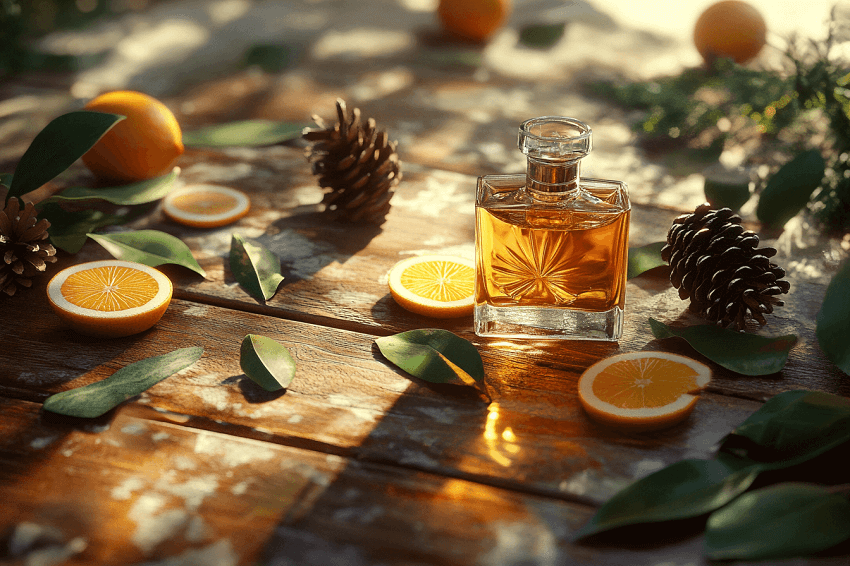
Additional Accessories
Light Diffusers: If you're shooting in direct sunlight, light diffusers can soften harsh light and prevent glare on glass surfaces.
Lens Filters: Polarizing filters can help reduce reflections on shiny surfaces, making it easier to capture clear images of glass bottles.
Part 2. Setting Up the Scene for Perfume Photography
Creating an engaging and visually appealing scene is critical in perfume photography. The way you set up your shot can dramatically influence the mood, focus, and overall impact of your images. Here are some key considerations for setting up the perfect scene for your perfume photography:
Background Choices
Minimalist Backgrounds: A clean, uncluttered background allows the perfume bottle to take center stage. Neutral colors like white, black, or soft pastels can create a sophisticated look that emphasizes the product's design.
Textured Surfaces: Using textured backgrounds, such as wood, marble, or fabric, can add depth and interest to your composition. Make sure the texture complements the fragrance's theme—elegant textures for luxury scents or natural surfaces for earthy fragrances.
Color Coordination: Consider the color palette of the perfume bottle and its packaging. Choose backgrounds that either contrast or harmonize with these colors to create a cohesive look. For example, a vibrant bottle may pop against a muted background, while a soft pastel fragrance might look stunning on a similar-toned surface.
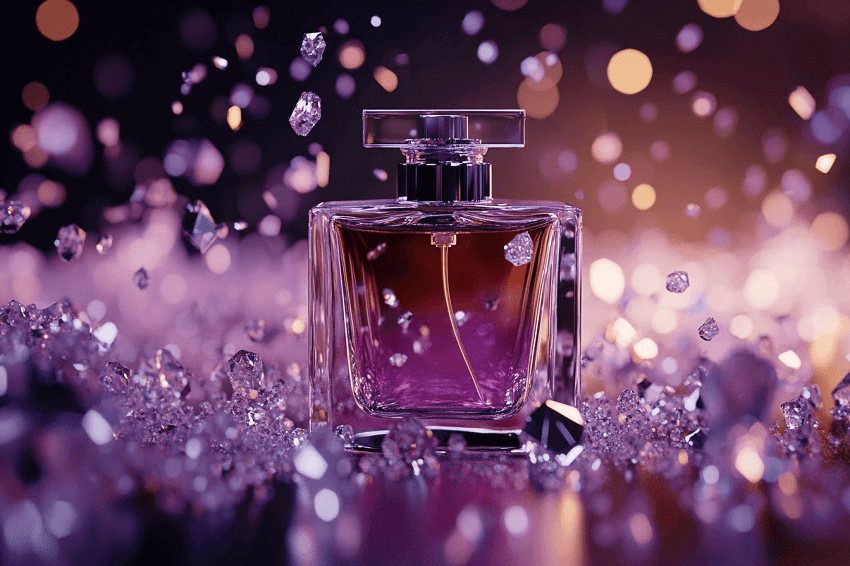
Props and Styling
Relevant Props: Incorporating props can enhance storytelling in your images. For floral fragrances, consider adding fresh flowers or petals; for fresh or aquatic scents, you might use elements like water droplets or seashells. Props should complement the product without overwhelming it.
Layering Elements: Use layers to create depth in your composition. This could involve placing the perfume bottle at different heights using stands or blocks, or arranging props in a way that leads the viewer's eye toward the focal point—the perfume itself.
Composition Techniques
Rule of Thirds: Utilize the rule of thirds to create balanced and engaging compositions. Position the perfume bottle off-center along one of the grid lines to draw attention and create visual interest.
Leading Lines: Incorporate leading lines in your setup to guide the viewer's eye towards the product. This could be achieved through the arrangement of props or by using natural lines in your background.
Negative Space: Don't be afraid to leave empty space around your subject. Negative space can help emphasize the perfume bottle and create a sense of elegance and simplicity.
Experimentation
Setting up your scene is an opportunity for creativity and experimentation. Try different arrangements, angles, and lighting setups until you find what works best for each specific fragrance. Take multiple shots from various perspectives to discover unique compositions that capture the essence of the scent.
Part 3. Creative Perfume Photography Techniques
When it comes to perfume photography, creativity is key to capturing the essence and allure of each fragrance. By employing innovative techniques, you can create visually stunning images that resonate with viewers and highlight the unique qualities of the perfume. Here are some creative photography techniques to consider:
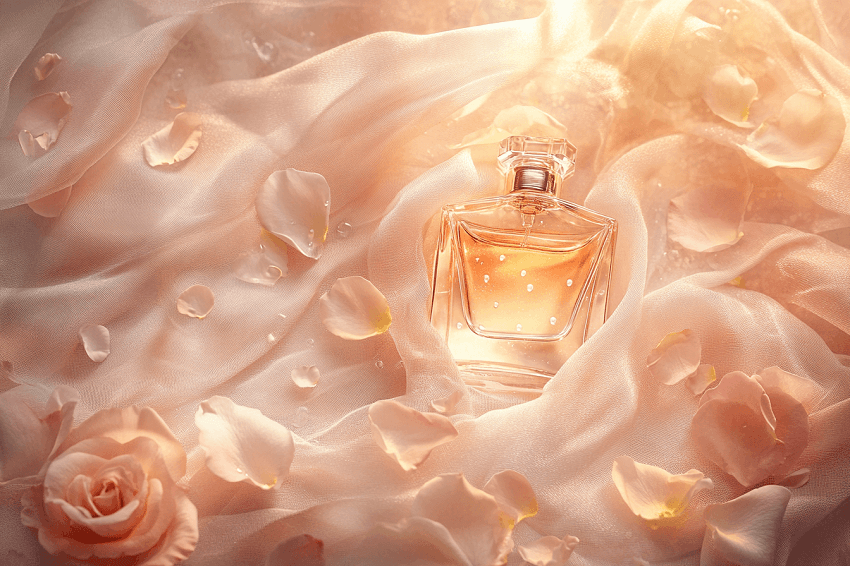
Lighting Techniques
Natural Light Manipulation: Utilize soft, diffused natural light to create an inviting atmosphere. Position your setup near windows with sheer curtains to achieve balanced lighting that enhances the perfume bottle's features. Experiment with different times of day to see how the light changes the mood of your images.
Dramatic Shadows: Play with lighting angles to cast interesting shadows that add depth and dimension to your shots. A single light source can create defined shadows that enhance the bottle's shape, making your images more captivating.
Incorporating Water Elements
Water Droplets and Splashes: Adding water droplets or splashes can evoke freshness and vitality associated with certain fragrances. Capture glistening droplets on the bottle or create dynamic shots with water splashes around it, enhancing the sense of movement and energy in your photographs.
Reflective Surfaces: Use mirrors or shiny surfaces to create reflections that add sophistication and elegance to your compositions. Position the perfume bottle strategically to capture its reflection, which can create a visually striking effect.
Utilizing Props and Natural Elements
Floral Arrangements: Surrounding the perfume bottle with flowers or leaves can create a harmonious connection between the scent and its natural ingredients. Choose props that complement the fragrance profile—floral scents paired with corresponding blooms or fresh scents surrounded by greenery.
Textured Backgrounds: Incorporate unique textures from your environment, such as wooden surfaces or patterned fabrics, to add visual interest. These elements can enhance the overall aesthetic and provide context for the fragrance being photographed.
Dynamic Action Shots
Capturing Use: Photographing a hand holding or spraying the perfume introduces a personal touch and emphasizes interaction with the product. This approach creates a relatable connection for viewers, allowing them to envision themselves using the fragrance.
Lifestyle Context: Consider incorporating lifestyle elements into your shots. Capture moments that reflect how the fragrance fits into daily life, whether it's on a vanity table surrounded by beauty products or in a serene outdoor setting.

Experimenting with Angles and Composition
Unique Perspectives: Don't hesitate to explore different angles—top-down shots can showcase the bottle's cap and overall shape, while side angles emphasize its profile and liquid inside. Experimenting with angles will help you find the most flattering perspectives for each bottle.
Rule of Thirds and Leading Lines: Use compositional techniques like the rule of thirds to create balanced images. Positioning the bottle off-center along grid lines can draw attention and make your composition more engaging. Incorporate leading lines from props or backgrounds to guide viewers' eyes toward the product.
Creating Mood with Color and Texture
Seasonal Themes: Tailor your scenes to reflect seasonal changes by incorporating elements like autumn leaves, winter snowflakes, or spring blossoms. This approach ties fragrances to specific times of year, enhancing their appeal.
Soft Focus and Dreamy Effects: Utilize shallow depth of field to create a soft focus on the perfume bottle while blurring out distracting elements in the background. This technique draws attention to the product and creates an ethereal quality in your images.
Part 4. Innovative Ideas for Perfume Photography
To truly capture the essence of a fragrance through photography, innovation and creativity are essential. Here are some innovative ideas that can inspire your perfume photography and help you create striking images that resonate with viewers:

Idea 1. Seasonal Themes: Tailor your settings and accessories to reflect different seasons. For example, use autumn leaves, winter snowflakes, spring blossoms, or summer sunsets to create a backdrop that ties the fragrance to a specific time of year. This not only enhances the visual appeal but also evokes the emotions associated with those seasons.
Idea 2. Elegant Simplicity: Adopt a minimalist approach by focusing on the perfume bottle against a clean, monochrome background. This technique highlights the bottle's shape, color, and texture, drawing attention to the product itself. Such simplicity can be particularly effective for social media and e-commerce platforms.
Idea 3. Natural Elements: Incorporate natural elements like flowers, herb leaves, or wooden branches to establish a connection between the perfume and its ingredients or scent profile. Surrounding a floral fragrance with corresponding blooms can enhance its appeal and authenticity.
Idea 4. Mysterious Atmosphere with Smoke: Utilize smoke to create an enigmatic atmosphere around the perfume bottle. The ethereal quality of smoke can suggest mystery and allure, perfect for deep, intoxicating scents. Backlighting the smoke adds drama and highlights the contours of the bottle against swirling patterns.
Idea 5. Luxury and Glamour: Surround the perfume bottle with luxurious elements such as jewelry, silk fabrics, or marble surfaces to emphasize its exclusivity and sophistication. This approach can elevate the perceived value of the fragrance and appeal to high-end consumers.

Idea 6. Dynamic Water Effects: Experiment with water by capturing droplets or splashes around the perfume bottle. This technique adds a refreshing feel, ideal for summer or aquatic fragrances. High-speed photography can freeze motion for vibrant and energetic images.
Idea 7. Creative Reflections: Use mirrors or reflective surfaces to create interesting reflections that add depth and sophistication to your photographs. This technique can enhance visual interest and provide a unique perspective on the product.
Idea 8. Lifestyle Context: Introduce human elements by photographing someone holding or spraying the perfume. This dynamic approach not only showcases the product in use but also creates a relatable connection for viewers, allowing them to envision themselves enjoying the fragrance.
Idea 9. Soft and Dreamy Effects: Utilize shallow depth of field to create soft focus on the perfume bottle while blurring out distracting elements in the background. This technique draws attention to the product and creates an ethereal quality in your images.
Idea 10. Futuristic Backgrounds: For modern fragrances, consider using sleek lines or geometric shapes in your backgrounds to evoke a futuristic feel. This innovative approach can help convey a sense of cutting-edge style that aligns with contemporary branding.
Idea 11. Showcasing Ingredients: Visually represent key scent notes by arranging corresponding ingredients around the perfume bottle—like citrus fruits for fresh scents or spices for warm fragrances. This not only enhances storytelling but also educates consumers about what they can expect from the fragrance.
Part 5. Post-Processing Tips for Perfume Photography
Post-processing is a critical step in perfume photography that can elevate your images from good to extraordinary. While capturing the perfect shot is essential, editing allows you to refine your work and enhance the visual appeal of your photographs. Here are some valuable post-processing tips to help you achieve stunning results:
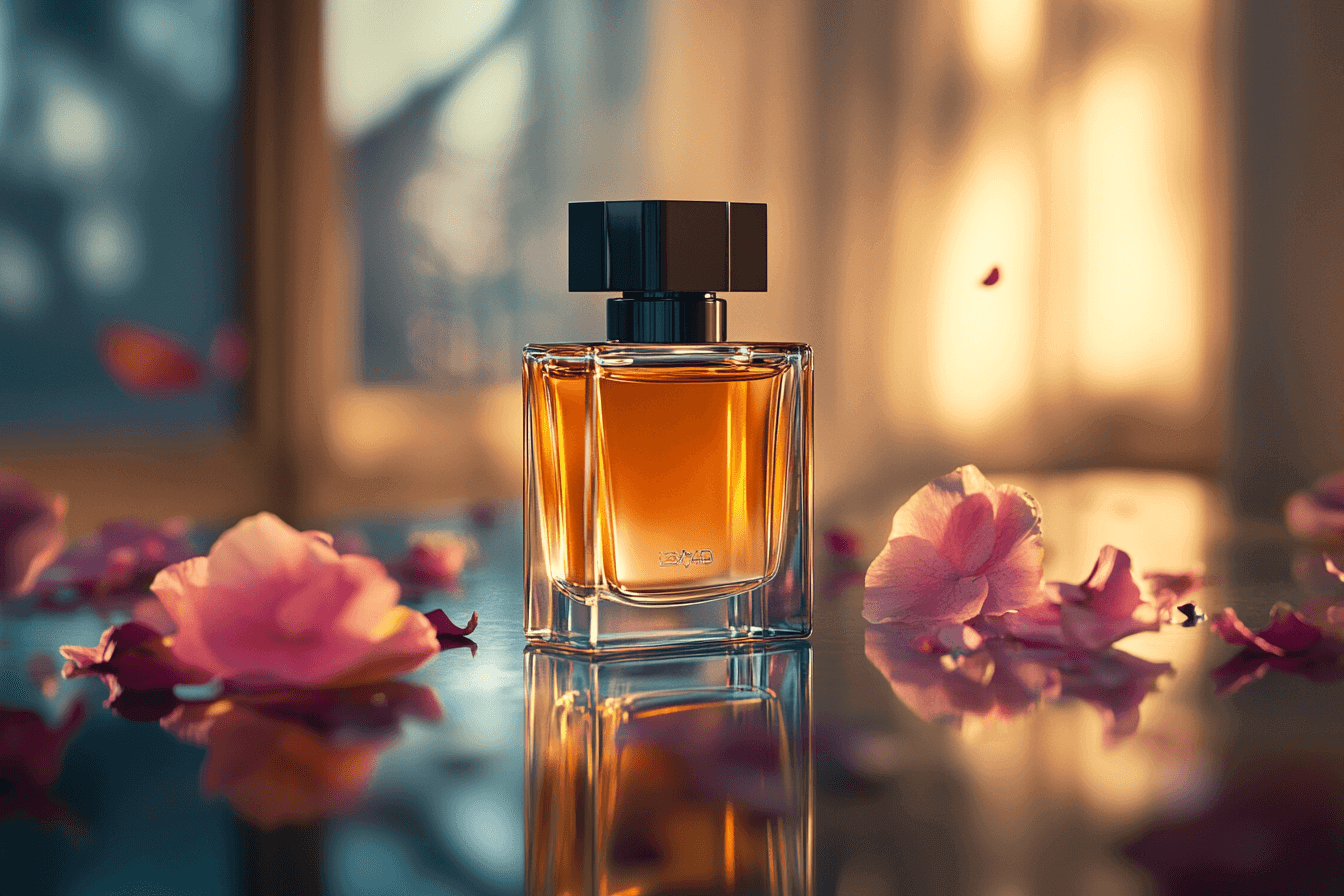
Tip 1. Choose the Right Software: Select a reliable photo editing software that suits your needs. Popular options include Adobe Lightroom for overall adjustments and organization, and Adobe Photoshop for more advanced edits. Both programs offer powerful tools to enhance your images effectively.
Tip 2. Adjust Exposure and Contrast: Begin by adjusting the exposure to ensure the image is well-lit without being overexposed. Increase contrast to add depth and dimension to your photograph; this helps highlight the perfume bottle's features and creates a more dynamic image.
Tip 3. Fine-Tune Colors: Use color correction tools to adjust the white balance, ensuring that colors appear natural and true to life. Enhance saturation and vibrance selectively to make the perfume bottle pop without oversaturating other elements in the image.
Tip 4. Sharpen Details: Apply sharpening techniques to enhance the clarity of the perfume bottle, especially if you've used a macro lens. Be cautious not to over-sharpen, as this can introduce noise or artifacts into your image. A subtle increase in sharpness can make a significant difference.
Tip 5. Remove Distractions: Utilize cropping tools to eliminate any distracting elements from the edges of your frame. This helps maintain focus on the perfume bottle and enhances overall composition. Additionally, consider using healing or clone tools to remove any blemishes or reflections that detract from the product.
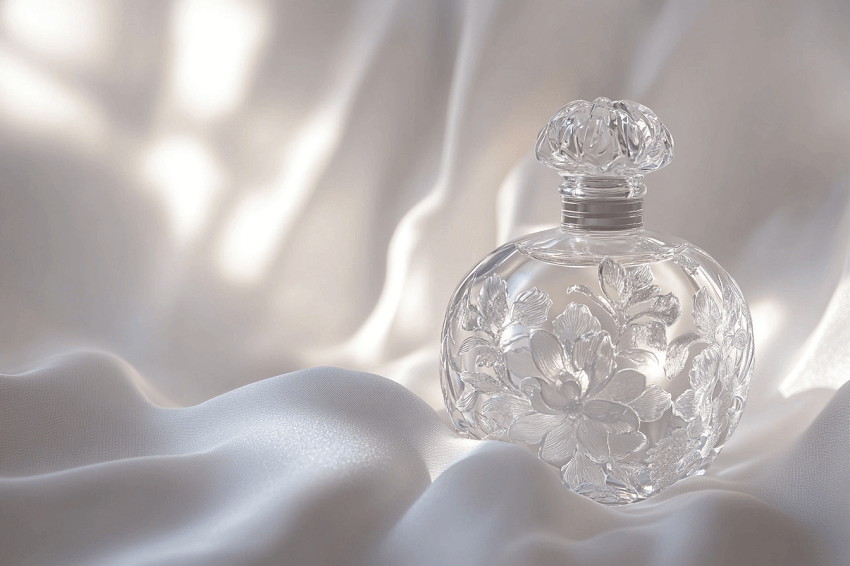
Tip 6. Enhance Textures: If your image features textured backgrounds or surfaces, use clarity adjustments to enhance these details without compromising the smoothness of the bottle itself. This technique can add depth and interest while keeping the focus on the product.
Tip 7. Create a Consistent Look: If you're working on a series of images for a brand or collection, aim for a consistent look across all photographs. This includes similar color grading, contrast levels, and overall style, which helps establish a cohesive visual identity.
Tip 8. Experiment with Filters and Presets: Consider using filters or presets that align with your desired aesthetic. These can streamline your editing process and provide a polished look to your images. However, always customize filters to suit each specific photograph rather than applying them uniformly.
Tip 9. Focus on Composition Adjustments: In some cases, you may want to adjust composition elements during post-processing, such as straightening horizons or cropping for better balance. This can help refine your image further and ensure it meets professional standards.
Tip 10. Save in Multiple Formats: When you're satisfied with your edits, save your images in multiple formats—high-resolution files for print and optimized versions for web use. This ensures versatility in how you present your work across various platforms.

Conclusion
Perfume photography is more than just capturing an image; it's about telling a story and evoking emotions that resonate with viewers. Throughout this guide, we've explored essential techniques, creative ideas, and post-processing tips that can help you elevate your perfume photography to new heights.
As you embark on your photographic journey, remember that experimentation is key. Don't be afraid to try new approaches, play with lighting, and incorporate unique props or backgrounds. Each fragrance has its own character, and your challenge is to capture that essence in a way that draws consumers in and makes them feel connected to the product.

